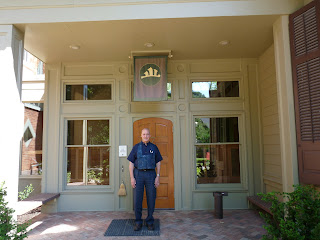When I
was working in International Development with the YMCA, I used to subscribe to
the National Catholic Reporter, in
part because it had a leftist slant on the Catholic Church—my birth
heritage—with which I was comfortable, but largely because it was one of the
best sources I could find for hard news coverage of events in Latin America. It
covered other stories of interest to Catholics as well, of course.
I first
learned of Father Robert Kennedy—a Dharma heir of Bernie Glassman—in an NCR article in which it was announced
that Kennedy, a Jesuit priest as well as an authorized Zen teacher, had
recently given transmission to a Trappist monk, Kevin Hunt [see photo]. If I
remember the article correctly, Father Hunt, when asked what a Trappist Zen
Master did, replied that he wasn’t sure but suspected he was going to find out.
Robert
Kennedy maintains the Morning Star Zendo in Jersey City. I was unable to meet
him face-to-face—he has a heavy travel schedule, trying to be available to
people who invite him to lead retreats wherever in the world that invitation
comes—so we had a conversation by Skype in which he explained that the Zendo is
really a one bedroom apartment in which a room has been set up as a meditation
hall.
Kennedy
had spent several years in Japan in the 60s, was ordained a Catholic priest in
Japan, without having any interest in Zen at all. After he returned to complete
his graduate studies in America in the early ‘70s, however, he was driving his
car one day and heard Alan Watts on the radio pointing out that “nothing in
nature is symmetrical.” “I don’t know why that statement hit me with the
strength that it did, but I had to stop the car and think. It was an
extraordinary moment.”
He went
back to his rooms, took a blanket off the bed, folded it to make a cushion, and
began sitting. His Zen practice had begun. “Something in my spirit said I had
to stop doing theology and turn to experience. Turn away from theory and learn
from my own doing.”
Eventually
he realized he needed to work with a formal teacher. He had a sabbatical in
1976 and went back to Japan—“not as a teacher this time, but as a pilgrim.” The
Jesuit order, which was committed to understanding other cultures and faith
systems, supported his desire to undertake Zen training and arranged for him to
meet Yamada Koun Roshi, the same teacher with whom Sister Elaine MacInnes had
worked.
Father
Kennedy remembers the first time he saw Yamada Roshi walk into the zendo. “I
was sitting in the back, up against the back wall, and I remember he walked in
to light the incense and to begin the day of sitting. I remember it vividly.
Again, I cannot explain it. The very sight of him walking into the zendo was
life changing.”
When
the sabbatical year was up, Kennedy continued training in the United States, at
Yamada Roshi’s suggestion, with Taizan Maezumi in Los Angeles. I mention that
in my interview with Jan Chozen Bays, she described the Los Angeles center as
half hippie-commune, half Zen temple. Kennedy pointed out that he didn’t live
at the center but had rooms in the Jesuit House so missed the hippie part of
the experience.
He met
Bernie Glassman in Los Angeles, and when Glassman received inka from Maezumi and returned to New York, Kennedy became his
student. Glassman’s approach to Zen training was very different from that of
Kennedy’s first two teachers. He had a strong sense of social responsibility
and, at one point, had his students living on the streets with the homeless,
having to beg for money if they wanted to buy a cup of coffee. “Glassman Roshi
said that a lot of people like Zen because they like to sit in a zendo and be
quiet and there’s a certain artistic flavor. The last time I saw him, a few
weeks ago, he said to me, ‘Some people like Zen clubs were they can sit
together with like-minded people.’ But he brought us out onto the street.”
After
Glassman acknowledged Kennedy as a Dharma heir, Kennedy’s first inclination was
to continue to sit by himself for a while in order to allow his practice to
mature, but Glassman immediately assigned him a student, a Catholic nun, whose
training he was put in charge of. Then other students began to appear. At first
they were Catholics, but then people from other—or no—traditions came.
He has
now acknowledged several Dharma heirs of his own, including the Trappist Father
Hunt. Hunt remains cloistered but, Kennedy informs me, meets with lay students
who come to him.
From
the first days that Zen began to be practiced in North America, there have been
Catholics who remained faithful to the church but were also drawn to Zen. Another
Trappist, Thomas Merton, was one well known contemplative who had an interest
in Zen. Apparently that interest continues. We probably still don’t know what a
Zen Catholicism would be like, but, with some luck, we might find out.
[Note: In May of 2014, I had an opportunity to visit and interview Kevin Hunt. See entry for 5/28.]
Cypress Trees in the Garden:
[Note: In May of 2014, I had an opportunity to visit and interview Kevin Hunt. See entry for 5/28.]
Cypress Trees in the Garden:
Kennedy, Father Robert – 134, 303-10,
318-19, 468, 469







